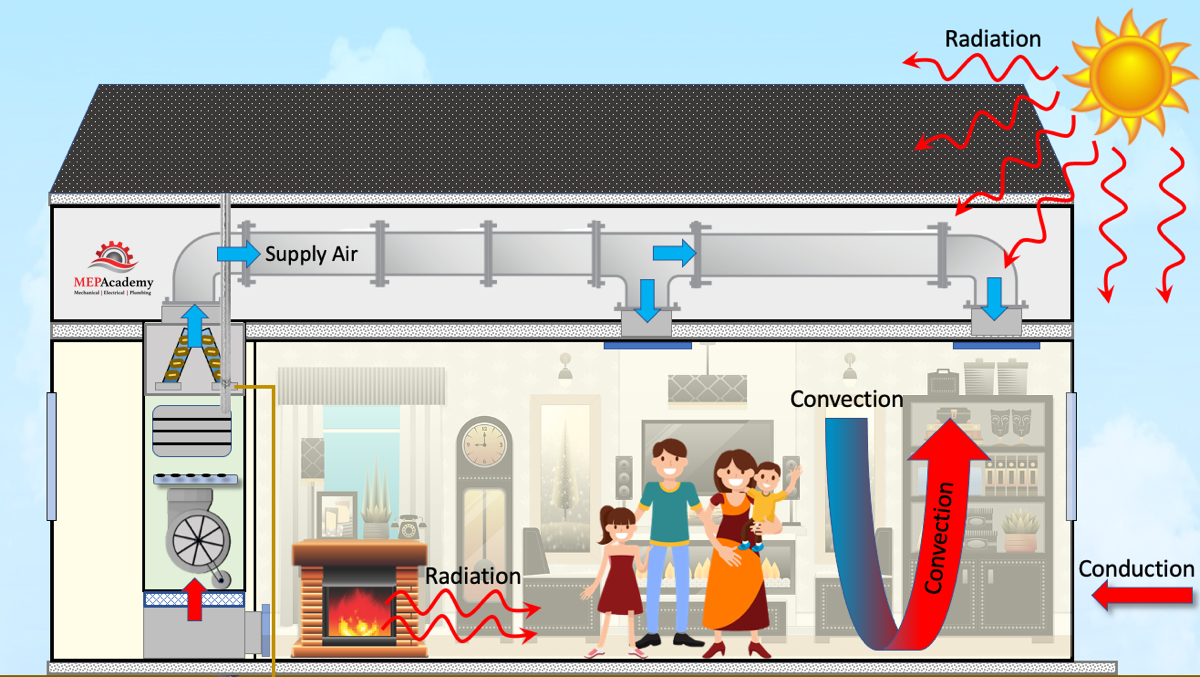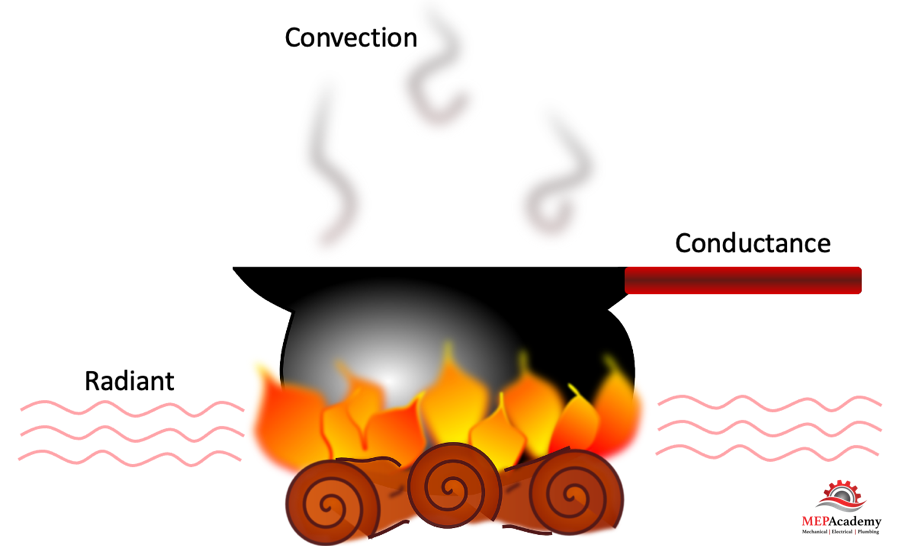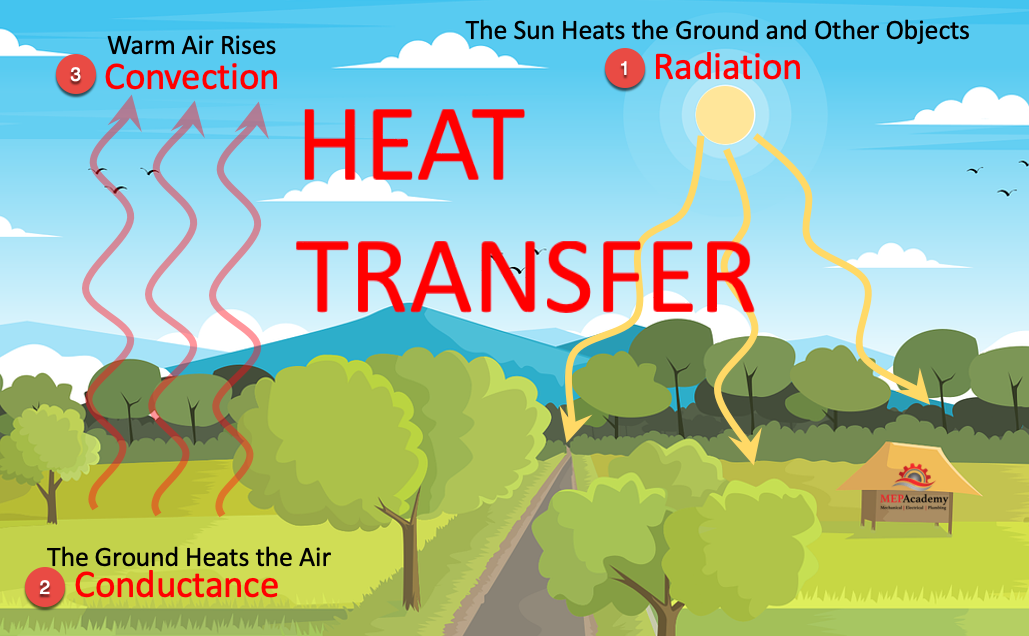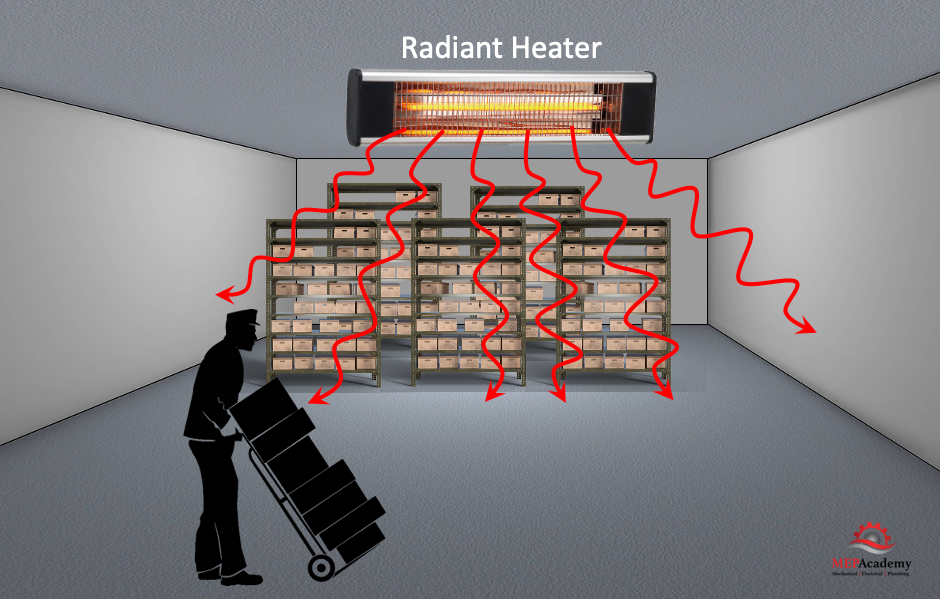How Heat Transfer Works. There are three basic methods by which heat transfers to and from objects. We’ll explain these three methods and how they’re used in the heating and cooling loads for the sizing of air conditioners and how heat is transferred to and from humans. The heat is measured in BTU’s or Joule.
If you prefer to watch the Video of this presentation, then scroll to the bottom or click on this link. How Heat Transfer Works.
According to the second law of thermodynamics, heat moves from a warmer object to a cooler one. This is how heat uses any of the three methods to move from the outdoors to the indoor environment, or to and from our bodies. We’ll explain the three methods of heat transfer using conduction, radiation and convection, and a fourth one for humans called perspiration.
Three Methods of Heat Transfer
No matter whether you’re at home or in the office, the methods of heat transfer are the same.

Conduction
Conduction is the easiest to understand because as a child you were told not to touch the stove or other hot surfaces or you’ll get burned. You’ll feel the heat transfer when you grab the hot metal handle of a pot on the stove, or touch an object that has been sitting in the hot rays of the sun. This is where heat is transferred by one object coming in contact with another, a direct object to object transfer.
Conduction occurs when heat is passed from one molecule to another in a chain reaction through an object. When heat is added to an object, its molecules speed up as does its temperature. These heated molecules bump into the adjacent molecules causes their velocity to increase and to heat up. This change reaction keeps occurring as long as heat is added or as long as there is an imbalance between molecules. This is most notable when heat is applied to a metal object that you come into contact with.

Conduction occurs constantly in the home or office when the outdoor temperature surrounding the walls, windows and roof is different than the indoor temperature. The heat will move through the construction materials at a rate defined by the resistance or “R” value of the material, the total square feet, and the temperature difference between outdoors and indoors. Q = A x U x Delta-T. The “U” value is the inverse of the total resistance of the wall or roof assembly.
The higher the “R” value the less the rate of heat transfer. This is how insulation reduces the heat transfer rate, while metals are highly conductive materials and easily move heat through them.

Radiation
Radiation occurs when the sun’s rays travel through space and strikes an object. That object absorbs the heat and can pass the heat along using any of the other heat transfer processes. This is one method by which heat gain occurs in buildings as it falls upon the structure and through windows.
If you have felt the warmth of a concrete or asphalt sidewalk or street after the sun went down or was blocked by clouds, this would be by conductance as the surface you touch is warm or the warm surface transfer its heat to the air that comes in contact with the surface. You could also feel the heat emanating from the surface as convection, as the air is warmed surrounding the surface and rises upward.

This is the same method by which infrared radiant heaters work. They radiate heat through the space until they land on an object that absorbs the heat, which could be a concrete floor in a manufacturing facility or someone working. The heat that hits the floor can than move through the concrete floor by conductance while also emanating upward in the air stream by convection. The walls, floors and ceiling can then radiate this heat back out to objects and the people surrounding the space.
Using the stove as our example again, we would feel the heat radiating out from the hot burner without actually having to touch it. Radiation acts like a waveform, emanating from a warm object to another object without effecting the space in-between. The walls, floors and ceiling can then radiate this heat back out to objects and the people surrounding the space.
To block infrared radiation from coming through windows there are now low-e coatings that can be installed that blocks infrared radiation.
Convection
Convection is the process of heat being dissipated by air motion. As hot air rises off the surfaces of walls it causes air motion that has an effect on human comfort. Heat is transferred from one area to another by the movement or flow of air, which is basically the movement of molecules. Since hot air naturally rises it will cause any heat in the space to be carried by air streams upward.
Air Conditioners and Heat Pumps
The heat that finds its way into your home or office is absorbed by the refrigeration system in your air conditioner or chilled water in some commercial buildings. The warm air is circulated over a refrigerant or chilled water coil where the heat is absorbed into the medium. See our video in the Refrigerant Cycle 101.
The Human Body and the Effects of Heat
The human body can give up heat through the three methods of heat transfer previously discussed, including a fourth one of perspiration.
Convection occurs when air moves across your body picking up body heat if the air is cooler. This causes the warmer air to rise, inducing cooler air to take its place. The faster the air moves the greater the cooling effect.
Radiation occurs when objects surrounding you are warmer than you are. This causes the object to radiate heat across the space between the object and you. By increasing the heat removal rate with ventilation, the cooler the object will become around you. When you are warmer than the surrounding objects, you’ll radiate heat out from your body.
Perspiration is one of the benefits of the human body as it facilitates the cooling of the body. As moisture evaporates from the skin it cools down the body while removing heat. When air blows across the body while perspiring the effects of evaporation is increased, providing an increased cooling effect.






